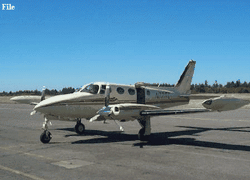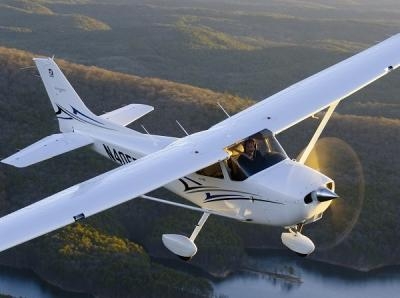Two Fatally Injured When The Plane Went Down Just After Takeoff
The NTSB has released its preliminary report in an accident involving a Cessna 340A on March 18 shortly before noon. The two people on board were fatally injured when the airplane impacted terrain.

The pilot of the Cessna 340 had apparently taken evasive action to avoid a midair collision with a Cessna 172 also departing from the airport.
TPF has two runways, runway 4/22, which was 3,580 feet long and 100 feet wide, and runway 18/36, which was 2,687 feet long and 75 feet wide. The runways intersected near their northern ends. There was shipping channel just east of, and parallel to runway 18/36.
At the time of the accident, a temporary flight restriction (TFR) was in effect at the time of the accident due to an airshow at nearby MacDill Air Force Base. The TFR extended in a 5-nautical-mile radius from the center of the base, from the surface to 15,000 feet unless authorized by air traffic control. The TFR extended over the southern ends of both runways at TPF. Multiple sources indicated that while the twin-engine Cessna 340 was taking off from runway 4, a single-engine Cessna 172M, N61801, was taking off from runway 36.
According to the report, the Cessna 340 was destroyed when it impacted terrain during an initial climb following a takeoff at Peter O. Knight Airport (TPF), Tampa, Florida. The airline transport pilot and the private pilot were fatally injured. Visual meteorological conditions prevailed. An instrument flight rules flight plan had been filed. The personal flight, to Pensacola International Airport (PNS) Pensacola, Florida, was operating under the provisions of 14 Code of Federal Regulations Part 91.
The airport did not have an operating control tower, and the common traffic advisory frequency (CTAF) was not recorded, nor was it required to be.
There were two pilots in the Cessna 172; the pilot in command (PIC) who had just passed his private pilot check ride at TPF, and a pilot-rated passenger, who had also been the PIC's flight instructor. The Cessna 172 was departing for its home airport following the check ride. In separate written statements, both pilots stated that the PIC made an advisory radio call indicating they would be taking off from runway 36. They also stated that they did not hear any other airplane on the frequency, with the PIC noting that they monitored frequency 122.725 [the CTAF frequency] from the taxi start point in front of the fixed base operator (FBO) to runway 36.
There was also a radio at the FBO, and a witness who was there at the time of the accident stated that he heard a radio call from the Cessna 340, and about 10-15 seconds later, heard what he thought could have been a call from the Cessna 172, but it wasn't as clear, partly because he was speaking to someone else at the time.
Airport and cross-channel security cameras captured the latter part of the accident flight. They partially showed the Cessna 340 taking off from runway 4 and the Cessna 172 taking off from runway 36.
The airport security camera was pointed such that the intersections of runways 4 and 36 were in the upper left quadrant of the video. The video initially showed the Cessna 172 on its takeoff roll. It lifted off the runway well before the runway intersection, continued a slow climb straight ahead, and gradually disappeared toward the upper left portion of the video.
When the video initially showed the Cessna 340, it was already about 20 feet above runway 4. It then made a hard left turn and appeared to pass behind the Cessna 172, still in a left turn, but climbing. It then appeared to briefly parallel the course of the Cessna 172, but the left-turn bank angle continued to increase, and the airplane's nose dropped. The airplane then descended, impacting the ground in an inverted, extremely nose-low attitude. During the impact sequence, the airplane burst into flames.
There was also a camera at a berth on the opposite (eastern) side of the shipping channel. The camera was pointing northward, up the shipping channel. However, the left side of the video also included part of the airport where runways 4 and 36 intersected.
In the recording, the Cessna 172 was first seen coming into view airborne off runway 36, and climbing straight out over the runway. As it neared the intersection, the Cessna 340 came into view, just lifting off from runway 4 and almost immediately beginning a hard left turn. The Cessna 340 continued the turn, passing behind the Cessna 172 while climbing and closing on the Cessna 172's right side. It almost reached Cessna 172's altitude, but continued the left turn onto its back, and descended into the ground. A fireball then erupted that initially extended well below and in front of the Cessna 172.
The Cessna 172 pilot-rated passenger, in the right seat, stated that as his airplane climbed through about 200 feet, he heard another airplane. He looked out the right window and saw the Cessna 340 almost directly below, "stall and crash." The PIC of the Cessna 172, in the left seat, stated that he heard but did not see what he thought was a twin engine airplane, then saw a fireball at the departure end of the runway he just departed.

The videos also recorded a boat heading north, mid-channel, in the waterway next to runway 36 when the accident occurred. A witness on the boat heard "screaming engine noise," which caused him to look toward the two airplanes. He saw that the "twin engine plane was behind and below the single engine plane." The twin engine airplane was in a left turn; it then caught a wing and slammed into the ground, with an "instantaneous" explosion.
The Cessna 340 impacted flat terrain about 40 feet to right of, and 250 feet from the departure end of runway 36, in the vicinity of 27 degrees, 55.16 minutes north latitude, 082 degrees, 26.87 degrees west longitude. The airplane was mostly destroyed in a post impact fire, and initial ground scars indicated an approximate heading of 010 degrees magnetic. Ground scars were consistent with the airplane having impacted at a high descent angle and inverted. However, the main wreckage came to rest right side up.
The fire consumed the majority of fuselage, from the nose of the airplane to the beginning of the empennage. Both wings were also substantially consumed by fire. The engines had separated from the wings, with the right engine found between the beginning of the wreckage path and the main wreckage, and the left engine found on top of the right wing.
Remnants of all flight control surfaces were found at the scene, but flight control continuity could only be confirmed between the wings and center cabin, and the tail and center cabin due to the extent of fire damage.
Both propellers were found broken off from their respective engines, and both sets of propellers exhibited blade leading edge burnishing, and bending and twisting. Engine crankshaft continuity was confirmed on both engines, as was compression. Significant thermal and impact damage was noted, but no preexisting anomalies were found that would have precluded normal operation.
(Images from file)
 ANN's Daily Aero-Term (04.25.24): Airport Rotating Beacon
ANN's Daily Aero-Term (04.25.24): Airport Rotating Beacon ANN's Daily Aero-Linx (04.25.24)
ANN's Daily Aero-Linx (04.25.24) Klyde Morris (04.22.24)
Klyde Morris (04.22.24) Airborne 04.24.24: INTEGRAL E, Elixir USA, M700 RVSM
Airborne 04.24.24: INTEGRAL E, Elixir USA, M700 RVSM Airborne 04.22.24: Rotor X Worsens, Airport Fees 4 FNB?, USMC Drone Pilot
Airborne 04.22.24: Rotor X Worsens, Airport Fees 4 FNB?, USMC Drone Pilot




